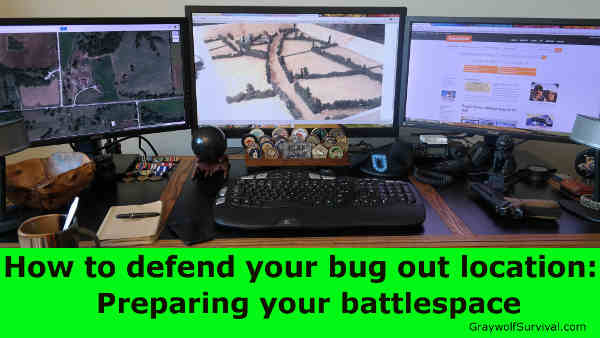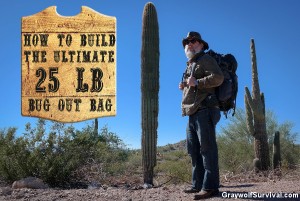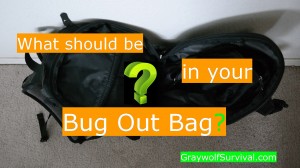 If you’re trying to defend a homestead or bug out location with a small group, you need to improve your odds by what are called force multipliers. One of the best ways to fight like a larger group is to prepare your battlespace.
If you’re trying to defend a homestead or bug out location with a small group, you need to improve your odds by what are called force multipliers. One of the best ways to fight like a larger group is to prepare your battlespace.
My Army buddy Mikey and I were tossing around ideas about tactical advantage in a SHTF scenario and as usual, he had some great points. He has a long history of tactical training and experience so I like to bounce ideas off him when it comes to things like that. He’s smarter than he looks. Rangers usually are.
This post will give you a few ideas to get you started but once you get the idea, you should be able to come up with your own, based on your location. Obviously, this is preparing for a worst-case scenario so normal safety precautions have to be measured.
What is a force multiplier?
A force multiplier, or combat multiplier, is something that allows you to fight like you were a larger group. Because a lot of preppers either go it alone or with their family, this an essential part of your plan to defend your home or bug out location. If you’re one of these people, you should seriously consider joining up with a group. Either way, a combat multiplier will help whatever size element you’re using.
There are many types of force multipliers out there, from psychological operations to better weapons to better tactics to better training. Today we’re going to be talking about prepping your geographical battlespace.
What is a battlespace?
A battlespace is exactly what it sounds like: the place where you fight. If you have a ranch or a bug out location, your battlespace is any area that you or your enemy can control. Today, we’re not only going to talk about controlling the battlespace, but prepping it so you can more easily fight against a group. We’re talking about how you can control the space that your enemy might find himself on.
Ideally, you’ll be in a rural location that you can do with what you like and have an area to work with. If you’re in a city, or even a suburb, this is more difficult but not impossible. There are some concepts that will translate to urban dwellings. You just have to think more about it.
If you have a fairly large area and group, once you’ve set all this up, you should have some sort of map that you can look at that shows everything in your area. A 3d sand table would be pretty awesome but at least have a map. That way not only can you see what’s going on with the map as you’re figuring out what to do, you can more easily explain to others what they need to do and where.
The castle defense
For thousands of years, man has made large and robust structures to defend what he had. Those eventually became castles and castles are easy to understand. They have thick walls and aren’t easily penetrated. You can do the same thing with your bug out location.
Unless you really want things to look pretty, one of the most effective ways to protect a small building against gunfire – and from being seen – is to cover it with dirt and rocks and plant things on it. Make it an above-ground bunker. This also protects you from a lot of ways someone could catch your place on fire.
If you’re not willing to do that, or can’t because of your situation, you can use sandbags, which can be found pretty cheap. They can be lined up outside around the whole house or inside in key locations. Of course, if you’re building from scratch, you should just factor in an extra thick wall and fill it.
The problem with castles is that if you’re sealed tightly inside, not only does it stop them from coming in, it stops you from coming out.
Preparing for a siege
One of the best methods to defeat someone who’s holed-up in a castle is to lay siege.
Let’s say you have a cabin in the woods. This is a pretty common idea for preppers and I like cabins. You have this awesome cabin in the woods and you stock up on food, medicine, ammo and other things like a good prepper does.
You decide that at some point, you may have a group of bad guys come and try to take all this prepper goodness or hurt your family so you shore up the walls with something to stop bullets and put metal plates on the windows and doors.
What happens if they decide to just camp outside and wait for you to come out?
You may have a year’s supply of food for your family and an endless supply of water but can you take care of all your waste? If you’re actively fighting, do you have enough ammo to hold out?
The first thing you need to do is set things up so that you could have an extended stay in your home. It may actually be just a bad winter that keeps you in for an extended stay but it’s the same thing. You’re fighting mother nature instead of a bunch of thugs.
Tunnels and cover
If you have a well-defended location, make sure you have an exit. Preferably, you should have several exits. This is one of the reasons I don’t like buried bunkers.
Obviously, you need an exit to get out if you can’t stay in your cabin or home any longer. They might just set fire to the place. If your only exit is out the front door then you’re now at their mercy. The best way to exit a sieged but out location is through a tunnel. A tunnel should be at least 50 meters long or head out to something that would provide cover as you exit such as over a hill or on the other side of a creek. Even into a woodline could work. Essentially, you need to get out without them knowing you got out.
If you can’t make a tunnel, you can do the next best thing and create above-ground cover. Having bushes or a trench near your home may provide you with a way to get out. The big problem is that something that provides you cover may also provide them cover.
Sniper’s hides and fox holes
Wouldn’t it be great if you had someone hidden that could just take out those guys one by one? Look at your ground and figure out where the best place would be to set up a shooter. Then set up that area so that shooter would be protected. You might consider a cache of water and ammo there as well.
Hopefully, you’ve thought ahead to either dig a tunnel from your bug out location to a couple of positions or at least set up some cover that he can move with. Obviously it isn’t really feasible to dig all kinds of tunnels throughout your property but they sure are more effective than pretty much anything else other than a Star Trek transporter machine.
Make sure your foxholes or other positions are sufficiently far enough away from your building that stray bullets from a gunfight won’t hit the house. The best locations are set out from the corners of the building so each can cover two walls.
Control the high ground
If you can get out of your home, or send someone out from your home, one of the things you can do is have them fight from the outside. Tactically, the high ground is usually the best place to fight from, especially if you have a way out the back. These might be a good location for a sniper but if you’re not planning on putting someone up there, do something so the bad guys can’t. Block off entrance to the best areas that you can’t use or put something right on top of it. Planting nasty things like yucca plants or a crapton of things you’d use normally for security hedgerows may be all you need.
Clear the area
If you want to fight someone, you need to see them. You also need them back from your area as much as possible to reduce their effectiveness. It may be nice to look out and see trees 10 feet from your porch but that’s a bad tactical decision. Clear out your yard so that you can see someone coming.
Control the enemy’s movement
Unless an attacker is just coming up to your front door, they’re going to set up fighting positions and command and control. If you’ve blocked off the high ground and other tactically-sound positions and cleared out your yard, these control positions will be away from your cabin, taking away some of their advantage. Congratulations, you’ve already started to control your enemy. Why not continue?
Guide his choice of positions
If you head outside and think like an attacker, you’ll start to see where he might set up and move his men. If you set up certain things like a large pile of dirt or a shed, you can start helping him decide where he’ll take cover. If you know where he’s taking cover, it’s easier to fight him. Places like these have been used for generations to set up boobie traps, security cameras and listening devices.
Guide his movement

If you’ve ever been trapping, one of the key elements of success is to channel your animal into your trap. This channel is sometimes just a natural animal path that gently guides an animal to follow and step into your trap but it can be even more effective if they have no choice but to follow along a wall and through a single hole, where your trap is waiting.
The same thing goes for prepping your battlespace. If you have hedgerows set up that he can’t cross, you know he’ll have to follow them to move from one area to the next. If you only have one break in those hedgerows, you know exactly where he’ll pop his little head out. By doing this correctly, you’ve effectively set up several fatal funnels that you can use.
If you’re in a full-on SHTF situation or are in a remote area, you might as well just go ahead and set up razor wire. Just remember that doing something like that will give away the fact that you’re defending something. Natural-looking hedgerows have the advantage that unless your enemy is well-trained in battle tactics, they won’t know their part of a defense strategy.
Improve your intelligence
Setting up cameras around your property will help you figure out how many guys are there, what they have and what they’re doing. A good quality flying drone with a camera would be one of the best things you could get in addition to ground cameras. That’s why the military uses them. They’re extremely effective.
If you don’t have cameras, you can set up some kind of signaling devices that work on tripwire to let you know someone’s made it to that position.
Call for help
If all else fails, your choice is to give up or ask for help. If you’re not going to actively decide to work with a group, you’re probably going to need help at some point if SHTF so you might as well work it into your plans. Even if you are, they can’t help you if they don’t know you need help. Make sure you have something like a ham radio with a reliable power source that you can call out with and some kind of communications plan with your family or group.
Get yourself a ham radio license and learn how to use the radios. Baofeng handhelds are super cheap so you can hand one out to each person in your family. There’s even an improved version now, called the BF-F8HP
, which has more power and a better antenna, that I would recommend more than the other version. They also transmit on channels that you don’t need a license for.
For your cabin or bug out location, I’d suggest a mobile unit like I have so you can bring it with you as you’re bugging out. I currently have a Yaesu FT-857D but the Yaesu FT-897D
is the same radio can hold two 12v batteries on the bottom. The 857d is better if you want to install it in a vehicle and the 897d is better if you want to carry it in a backpack or case and bring it along. Both will work perfectly well as a base station, and both can be taken in a pack.
Check out the book Stealth Amateur Radio: Operate From Anywhere though if you’re going to be operating a ham radio at a bug out location. There are some pretty simple tricks that you can adapt to most situations.
If a radio isn’t going to work (or doesn’t work at the time), set up some other kind of signal such as a loud horn or tower bell that can be rung. Just be creative and have a plan in place before you need to execute the plan.
These are just a few ideas. Just remember that a fight can be won or lost before it’s even begun. By coming up with certain force multiplier tactics ahead of time, you can sway things to your advantage.
If you’d like more information on how to protect your home or bug out location, check out Prepper’s Home Defense: Security Strategies to Protect Your Family by Any Means Necessary












Great advice! For now, I’d be very happy with just some fencing or wire! I don’t want to engage potential threats inside my home, or at the front door. We can defend the 4 cardinal directions, North, south, East and West with substantial firepower. We just need to stall, delay or fix marauders at the perimeter.
Great article, Scott! Lot’s to think about.
Especially liked the idea of using a drone to gather intelligence. Not a novel idea, I realize. 😉 And it’s a great way to give you a massive advantage.
But at $999, the drone you linked to is a bit out of my price range. So I poked around youtube.
There are a bunch of youtube videos showing how to make and/or modify these for cheap money. Like under $50.
And the cameras – even an $8 key chain “spy cam” – are surprisingly good.
Pretty neat!
There are absolutely cheaper ones out there, and in a lot of cases they’ll work fine. The problem is that they’re almost all just toys. If you’re going to use it for base defense, you need to step it up a bit to make sure it does what you need it to do and will keep on doing it.
My friend happens to use this model for his photography business, and he actually has another version of it now I think.
Because there are a lot of crap ones out there, I didn’t want to recommend something that I don’t feel confident in knowing it’ll work.
Makes sense! Caveat Emptor, to be sure.
And all of these inexpensive drones literally were toys repurposed.
But I was surprised by what’s available, their capabilities, and various “experiments” folks are working out with them — all for very little money.
Thanks again for the article.
The use of UAV’s is something I will definitely be using to help patrol the area around my Bug out Location. My experience from them comes first hand use in Iraq as a Marine Corps 0311. I was tasked with learning and flying the WASP and the Raven to assist my company in it’s patrols. The things they can allow you to see are amazing. If you have a group and your are stretched as is with manning a OP and the daily duties of the land you may not have time to conduct patrols. These UAV’s allow you to see well beyond your land and can help you spot a possible enemy before he sees you.
Not only are they useful to spot future problems coming your way they are useful during combat zones. It’s hard to see which way your enemy went when your ducked behind cover, I don’t care what people see in Hollywood movies when you lose sight of your target and your hearts pounding and your ears have plugs in them or are deadened from shooting without them, you wont find your target. But with a UAV in the air someone in your group can keep a eye on them and relay their position to you. Allowing you to cut them off, corner them, and eventually capture them.
In the case of an extreme emergency, the only way we will survive is by working together. It will take all of us co-operating to survive a major disaster. That is the way it has always been.
Prepping is a hobby by people with weak imaginations.
I’d rather not be caught with my pants down if the SHTF. Why not be prepared if your able to, especially if the military has already trained you? We all saw what happened in New Orleans during Hurricane Katrina and nobody was prepared, did people work together? That’s a big FAT NO!
Just found these articles. Would like read any updated material or new stuff. Thank you for the helpful hints.
Try having your group run mock drills with paintball. It’s a great way to learn the land, strategic points etc.
All around good advice.